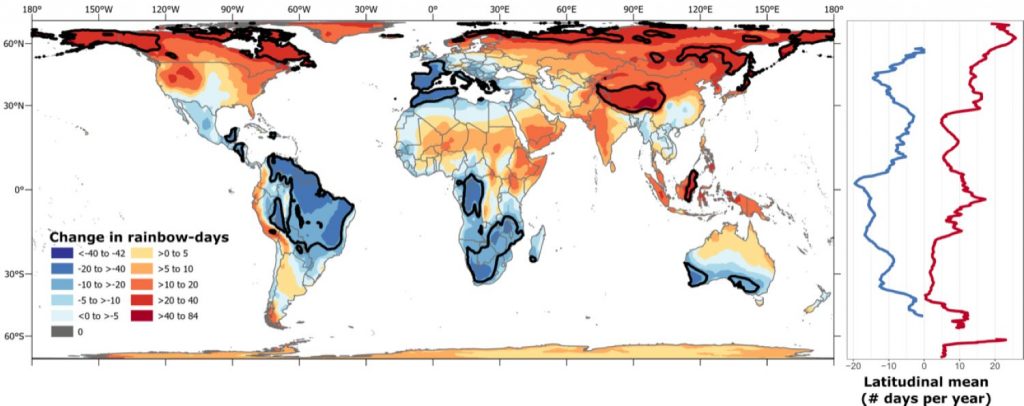One good thing about climate change: More rainbows, UH study predicts
Already dubbed the “Rainbow Capital of the World,” the Hawaiian Islands are predicted to experience a few more days with rainbows per year thanks to climate change.
Yep. You read that correctly. The scourge that threatens the health and livelihood of humans and other life on the planet will increase opportunities to see rainbows, according to a study led by researchers at the University of Hawai‘i at Mānoa.
And it looks like the Hawaiian Islands will continue to be prime viewing locations. The study suggests islands are rainbow hot spots.
“Islands are the best places to view rainbows,” according to Steven Businger, professor of atmospheric sciences at the UH-Mānoa’s School of Ocean and Earth Science and Technology. “This is because island terrain lifts the air during daily sea breezes, producing localized showers surrounded by clear skies that let the sun in to produce majestic rainbows.”

Sunlight and rainfall are the main ingredients for rainbows. Human activities such as burning fossil fuels are warming the atmosphere, changing patterns and amounts of rainfall and cloud cover.
It’s estimate that by 2100, the average land location on Earth will experience about 5% more days with rainbows than at the beginning of the 21st century. Northern latitudes and very high elevations, where warming is predicted to lead to less snow and more rain, will experience the greatest gains in rainbow occurrence.
However, places with reduced rainfall because of climate change — such as the Mediterranean — are projected to lose rainbow days.
“Living in Hawai‘i, I felt grateful that stunning, ephemeral rainbows were a part of my daily life,” Kimberly Carlson, lead author of the study who is now at New York University’s Department of Environmental Studies, said in a press release. “I wondered how climate change might affect such rainbow viewing opportunities.”
Camilo Mora is with the UH-Mānoa Department of Geography and Environment. He was intrigued by Carlson’s question and pitched it as the focus of a project for one of his graduate courses.
“We often study how climate change directly affects people’s health and livelihoods, for instance via the occurrence of heat stroke during climate change-enhanced heat waves,” Mora said in the press release.
However, few researchers have examined how climate change might affect the aesthetic qualities of the environment. Until now, no one had mapped climate change’s impact on rainbow occurrences.
A team that included UH-Mānoa students at looked at photographs uploaded to the social media platform Flickr. They sorted through tens of thousands of pics labeled with the word “rainbow” that were captured from around the world and identified rainbows generated from the refraction of light by rain droplets.
That wasn’t an easy task.
“We had to sort through photos of rainbow artwork, rainbow flags, rainbow trout, rainbow eucalyptus and rainbow foods to find the real rainbows,” Amanda Wong, one of the study’s co-authors who was then an undergraduate student in global environmental science in the School of Ocean and Earth Science and Technology, said in the press release.
The researchers then trained a rainbow prediction model based on rainbow photo locations and maps of precipitation, cloud cover and sun angle. Finally, they applied their model to predict present day and future rainbow occurrences over global land areas.
The authors stopped short of discussing how changes in rainbow occurrence might affect human well-being. However, rainbows are an important part of human culture throughout history and around the world and are aesthetically pleasing.

It seems people will have more opportunities to make a rainbow connection because of climate change.
“Climate change will generate pervasive changes across all aspects of the human experience on Earth,” Carlson said in the press release. “Shifts in intangible parts of our environment — such as sound and light — are part of these changes and deserve more attention from researchers.”








